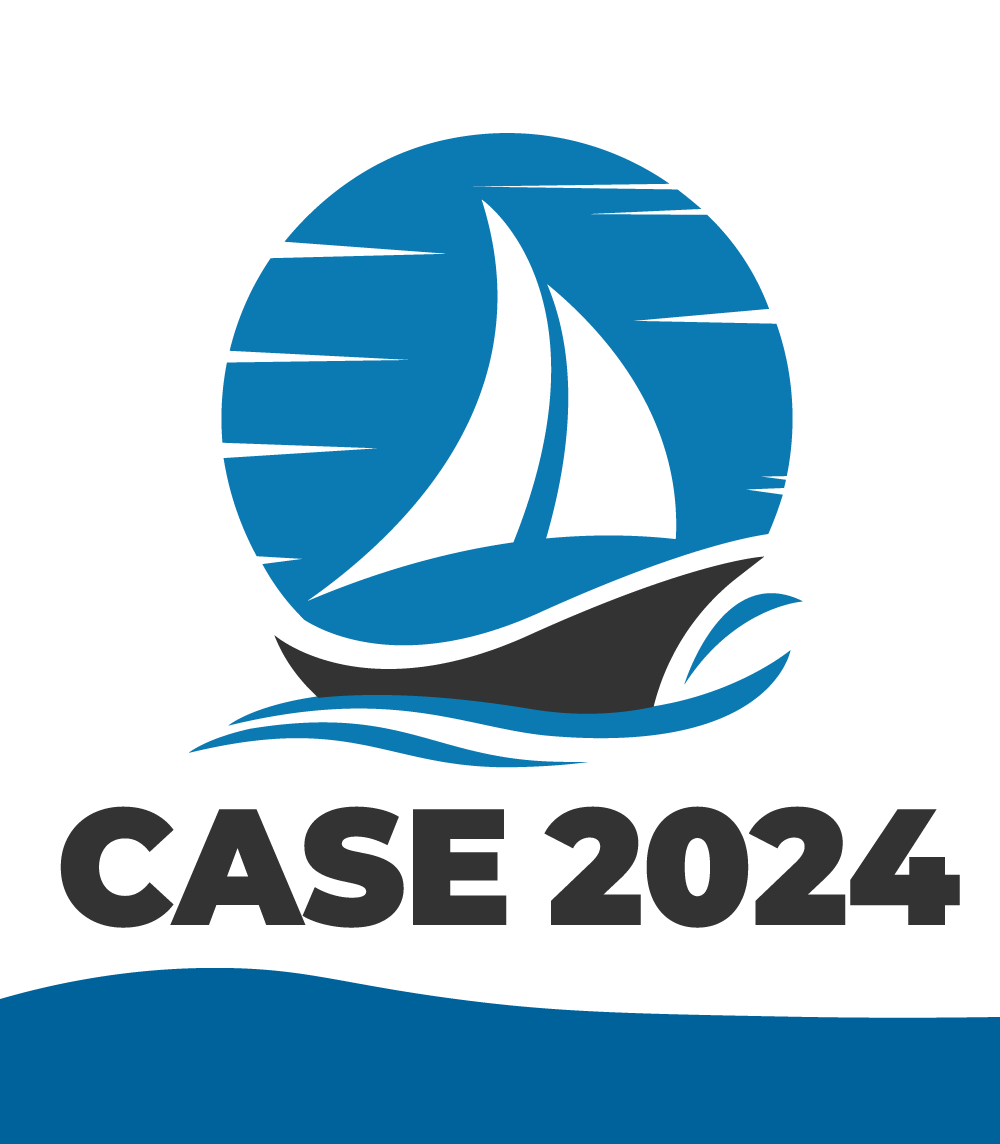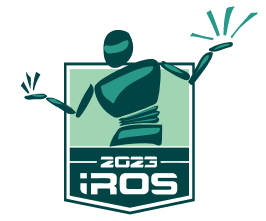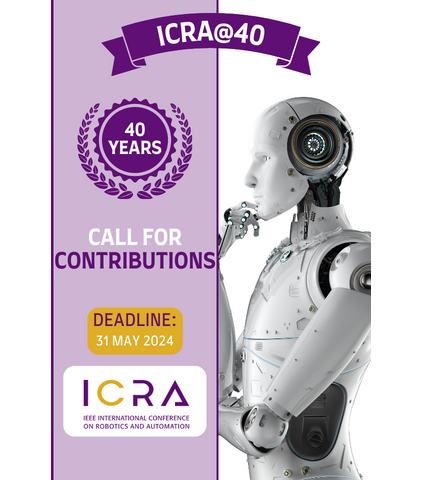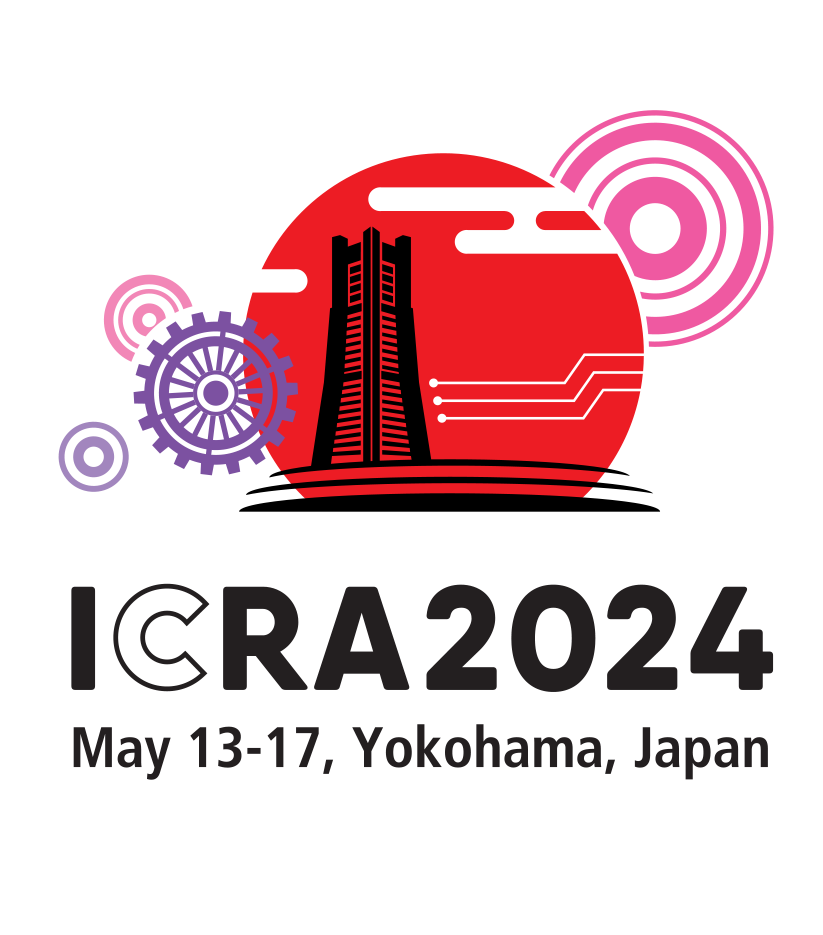RA-L Information for Authors
Scope
The scope of RA-L is to publish peer-reviewed articles that provide a timely and concise account of innovative research ideas and application results, reporting significant theoretical findings and application case studies in areas of robotics and automation.
Keywords
Specifically involved are the topical areas and keywords listed here. All keywords should be interpreted as requiring relevance to robotics and/or automation. For example, "Deep Learning Methods" represents "Deep Learning Methods in/for Robotics and Automation".
Submission site
Papers for RA-L and RA-L with conference option are submitted through the Paperplaza system: ras.papercept.net/journals/ral. Make sure to read this webpage in its entirety before submitting.
Types of Submission
Letters:
RA-L will publish manuscripts reporting on innovative ideas and results that need to be rapidly published in a concise form.
Letters are six pages long in two-column IEEE format (see below for details), including figures and references, with up to two extra pages with extra page charges, for a maximum of eight pages. Inclusion of multimedia material – videos, data repositories, code sources, etc. – are welcome. Other supplementary material, such as appendices, cannot be included beyond the allowed eight pages.
RA-L is an electronic-only, hybrid open-access journal. The final version provided by the authors will be rapidly posted on IEEE XPlore, and will be replaced by an edited, XML tagged version soon after. Submission of Letters to RA-L is open throughout the year.
Submitted manuscripts will be either published within six months from reception or rejected during peer review. RA-L papers are published online very soon after acceptance, so authors should complete any intellectual property/patent steps before submission.
RA-L uses single-blind review: The articles in this journal are peer reviewed in accordance with the requirements set forth in the IEEE Publication Services and Products Board Operations Manual (https://pspb.ieee.org/images/files/files/opsmanual.pdf). Each published article was reviewed by a minimum of two independent reviewers using a single-blind peer review process, where the identities of the reviewers are not known to the authors, but the reviewers know the identities of the authors.
Submitting a previously published Conference paper and the “evolutionary paradigm”:
The RA-Letters will not consider submissions that are currently under review for a conference.
In principle, RA-L may consider submissions that have been published in the Proceedings of an IEEE conference, provided that the manuscript follows the “evolutionary paradigm” of IEEE, i.e., if it incorporates substantial improvements and it openly discloses the source(s) and discusses the changes. However, because the length of a Letter is comparable to that of most Conference papers and RA-L are intended to publish novel results rapidly and concisely, the application of such “evolutionary paradigm” to Letters is difficult. Submission to Transactions of an evolved version of a previous conference paper is instead considered natural. Notice that the “evolutionary paradigm” does not apply between Letters and Transactions, because they are both archival Journal publications.
Submitting a previously rejected paper:
In some cases, RA-L Editors encourage authors of a rejected paper to consider rewriting it and resubmitting it as a new submission. This may happen when we recognize that ideas proposed are good, but the signficant changes needed to make the paper publishable are too substantial to fit in the tight RA-L schedule for publication. Papers that have received a decision of "Rejected" or "Unsuitable" are both considered rejected papers.When submitting a new version of a previously rejected paper, authors MUST
- Indicate the submission number of the previously rejected version in the Paperplaza submission process
- Prepare and include with your submission a single pdf file that includes: (1) an authors' response providing details on how each comment received from the Editors and Reviewers has been resolved in the new version, followed by (2) a version of the paper with changes from the previous version highlighted (e.g., with modified text in a different color). Failure to do so may result in automatic rejection of the resubmission. Please provide the title and number of the previously rejected paper in your response file.
- Immediately after the new paper is submitted, forward the submission confirmation email to EiC.RA.Letters@ieee.org. Please edit the submission confirmation email as follows
- Add the tag [previously rejected paper] to the subject line of the email
- Provide the number of the previously rejected paper and the number of the new submission.
Best Paper Awards
Every year, the Editorial Board selects papers appeared in the previous year for an IEEE Robotics and Automation Letters Best Paper Awards.
Review Procedure
After the first submission of their manuscript, authors will be notified of reception and of the Editor of RA-L who will supervise the review. Authors will receive the first decision, along with review comments, within three months from submission.
The first decision can be one of three types: Accept for Publication, Reject, or Revise and Resubmit.
If the first decision is Accept for Publication, authors are required to submit the camera-ready version of their paper within two weeks.
If the first decision is Revise and Resubmit, authors can resubmit a revised version along with an Author Response and Diff File indicating how comments by the Editor and by reviewers have been addressed. This is a single pdf file that includes: (1) A detailed response to the review that explains how each comment received from the Editors and Reviewers have been resolved in the new version, followed by (2) A version of the paper with changes from the previous version highlighted (e.g., with text in a different color). Failure to do so may result in automatic rejection of the resubmission. The revision must be resubmitted within 30 days from receipt of the first decision. Failure to meet this deadline means the paper will be automatically moved to the Reject category: unfortunately, the tight timeline of the Letters will allow no extensions or exceptions to this rule.
Authors will receive a second and final decision within 5 months from initial submissions. Final decisions are only of two types, Accept for Publication or Reject.
If the final decision is Accept for Publication, authors are required to submit the camera-ready version of their paper within two weeks. This final version must also be acommpanied by an Author Response and Diff File as described above. The Editor verifies that the final version of an Accepted paper satisfies all conditions indicated in the Acceptance letter. The Editor can withhold publication until all required changes are satisfactorily made. In addition, the Editorial Assistant will check that the paper formatting is correct. Formatting revisions must be made immediately and also accompanied by a very brief Author Response and Diff File explaining only how the formatting was corrected.
Upon receipt of the final version of the paper from the authors, and provided that all formatting and style requirements are met, the camera-ready PDF file will appear as a Rapid Posting preprint on Xplore. Rapid Posting preprints are citable papers and have a DOI.
Any paper submitted to RA-L will be published on IEEE Xplore within six months, or be rejected during the peer review process.
Shortly after Rapid Posting preprint appearance, a moderately edited and XML tagged version will be prepared by IEEE, submitted as galley proofs to the Authors, and eventually published in replacement of the preprint.
IEEE Policy Regarding Intellectual Property Protection
IEEE takes the protection of intellectual property seriously. Accordingly, all submissions will be screened for plagiarism using iThenticate CrossCheck software. By submitting your work you agree to allow IEEE to screen your work. For more information please visit: http://www.crossref.org/crosscheck/index.html.
Manuscript Preparation
Page Length:
Letters will be six pages long, with at most two extra pages allowed at a charge ($175 per extra page). These page limits include everything needed for publication, e.g., figures, tables, and any appendices. DO NOT attempt to submit supplemental text or figures for the letter as multimedia materials or in the Author's Response document; this will be grounds for editorial rejection without review.
Paper Format:
All manuscripts should be submitted in the double column format of the IEEE style file. Instructions and templates (LaTeX or Word) are downloadable from the IEEE "Article Preparation and Submission" section of the IEEE Author Center, together with other useful tools for authors.
For compatibility reasons, the first submission to the Letters will be formatted as a RAS conference manuscript. The final version of an accepted Letter however will have the same editorial style of other RAS journals.
Initial Submission:
If you use LaTeX for preparing a Letter, please download the following files for document preparation:
If you use MSWord for preparing a Letter, please download the following files for document preparation
When using the IEEE style format, the first (title) page will contain the paper title and each author's name, affiliation, and full address (mailing address, email address, and fax number), with the corresponding author clearly indicated, the abstract (no more than 200 words), the keywords (index terms), and the beginning of the main text of the paper. Do not use a cover page.
|
Final Submission:
|
Upon acceptance of the manuscript as a R&A Letter, there are two important tasks for Authors. Notice that Acceptance in RA-L is always conditional on Authors fulfilling the following two requirements WITHIN THE (STRICT) DEADLINE given. Failure to comply with either requirement will lead to disapproval of the final submission, and a request of re-submission.
Below you can find detailed instructions on the format for final submission. First you should look at an EXAMPLE of how the final version of your paper should look like. Here is the source code used to generate the example. Please make sure you the exact text below and customize all text bold underlined in the list below. Explanations provided in [bracketed italics] are not to be included; these are for explanation only.
Detailed instructions on how to format your LaTeX or MSWord sources to submit follow: Formatting Final Manuscripts in LaTeXIf you use LaTeX, please visit http://ieeeauthorcenter.ieee.org/create-your-ieee-article/use-authoring-tools-and-ieee-article-templates/ieee-article-templates/templates-for-transactions/ and download the LaTeX class file ieeetran.clsIn what follows, fields to be customized are shown in bold underlined Formatting Final Manuscripts in MSWordIf you use MSWord for preparing the final version of a Letter, you will have to reformat your first submission according to the IEEE Journal template available here. 1) Use this line as header of first and all even pages: In your text, make sure to put at least two and up to five RAL keywords just beneath the abstract
Keywords SelectionA list of significant keywords (also named index terms) must be associated with each submitted paper. Select a minimum of 2 up to a maximum of 5 (recommended) keywords during one of the submission steps at the RA-L Papercept site ras.papercept.net/journals/ral. The first two keywords must be chosen from those predefined within the RA-L set. Additional keywords can be selected from the same list. You can also type in freely at most 2 keywords, up to a total of 5. The current list of predefined RA-L keywords can be downloaded here. PDF File TestingAs you have noticed in the instructions above, the format of papers for initial and final submissions to RAL are different. The initial submission is in IEEE conference format and must rigidly respect the margins that are enforced by the paperplaza submission system. The final submission of an accepted paper instead has the style and look of an IEEE Journal. InquiriesAll pertinent correspondence relating to publications should be sent to the Editor-in-Chief at EiC.RA.Letters@ieee.org. For technical issues regarding manuscript submission, please contact Paperplaza at ral@ras.papercept.net. |
Multimedia Materials
RA-L considers also multimedia attachments for material accompanying the submission of a paper. The multimedial materials must be submitted at the same time as the paper. Multimedia materials can include:
- videos (Only one video is allowed per submission)
- dataset files (e.g., raw data with programs to manipulate them)
- source code
- readme and instruction files
DO NOT submit supplemental text or figures as multimedia materials, as this would circumvent RA-L page limits. Multimedia material is intended to enrich the contents of a paper, both in clarity and in added value, without adding text. IEEE has general guidelines for the submission of multimedia, ranging from the format, to the description of content and of user requirements, and to the way this material should be referenced to in the body of the paper. This information is available in the "Multimedia Materials" section of the IEEE "Author Center" through this link. In preparing multimedia material, it is recommended to follow the general IEEE guidelines right from the initial submission. In addition, specific guidelines hold for the Robotics and Automation Letters:
- The paper should be self-contained, i.e., fully readable and understandable independently from the multimedia material.
- See the RAS Video Submission Guidelines
- A "ReadMe.txt" file (in ASCII text format) should accompany the multimedia material describing:
- Minimum requirements for the user. In particular, provide the version of the software that is required to play/run the submitted files. Include the name of the software, the version number, and any special requirements for the player
- Contact Information. The author should provide contact information in case users have questions regarding the multimedia material (IEEE will not provide any technical support for this)
- A "Summary.txt" file (in ASCII text format) succinctly describing the contents, usage and value of all multimedia objects
Authors submit their multimedia material as a single zipped archive file (max 50 MB) during paper submission at the RA-L Papercept site ras.papercept.net/journals/ral. If you have multiple video clips, it should be edited into one single video file.
The multimedia material will be reviewed together with the submitted paper. Once a paper and its associated multimedia material is accepted, the latter will be available in the RA-L page within IEEE Xplore, side-by-side to the PDF of the paper.
Copyright and E-Copyright Form
It is the policy of the IEEE to own the copyright to the technical contributions it publishes on behalf of the interests of the IEEE, its authors, and their employers, and to facilitate the appropriate reuse of this material by others. To comply with U.S. copyright law, authors are required to sign an IEEE copyright transfer form with the final manuscript. For your information, this form is available here. It returns to authors and their employers full rights to reuse their material for their own purposes. Authors of accepted manuscripts should fill the electronic copyright transfer form (E-Copyright) at the time of final submission of the material for publication.
Policies on posting your article online (such as for class use or with arXiv.org) are provided here: https://ieeeauthorcenter.ieee.org/publish-with-ieee/author-education-resources/guidelines-and-policies/policy-posting-your-article.
Open Access
RA-L policies on Open-Access publishing are the same as general IEEE policies. The majority of all IEEE transactions, journals, and letters offer a hybrid option, which permits both traditional subscription-based content as well as open access, author-pays content. For all hybrid journals, the review process for OA and traditional articles is the same. Any open access papers published within a hybrid journal will be included in all media types offered by that title.
Authors using government research funding or university consortium funding may be required to publish in OA journals; check with your research sponsor about this. In addition, authors may choose to pay to publish open access in order to gain the largest possible audience for their research.
Letters will allow open-access for those authors who require it and who support publishing costs directly. Any communication regarding the Open Access choice will only be entertained after the final decision about publication. The peer-review process is indifferent to articles being OA or not. Reviewers will not know if an article is OA or not. Authors’ commitment to OA is only made after acceptance.
The open access article processing charge (APC) for this publication is USD $2345 for all articles accepted on or after 1 January 2023. Other applicable fees (e.g. over-length paper charges) remain unchanged.
ORCID
All IEEE journals require an Open Researcher and Contributor ID (ORCID) for all authors. ORCIDs enable accurate attribution and improved discoverability of an author’s published work. The author will need a registered ORCID in order to submit a manuscript or review a proof in this journal.Follow these steps to link a PaperCept account to a registered ORCID. Note that PINs from different sub-domains can be linked to a single ORCID.
- Go to the start page of the PaperCept subdomain where you have an existing PIN (if you do not have one, please create one by following the PIN link from the PaperCept subdomain of interest).
- If you do not already have an ORCID, follow the link “Register an ORCID,” create an ORCID and return to the PaperCept login page.
- Follow the link “Register your ORCID with any of your PaperCept PINs,” enter your registered email or the ORCID and password and then click on Authorize.
- Once you authorize the ORCID to be linked to your PIN you will be returned to the PaperCept subdomain from where you accessed ORCID.
- Follow “Log in to any account associated with this ORCID” to complete associating your PIN to the ORCID.
- If you have inadvertently created multiple PINs in the same subdomain, you can associate all PINs with the same ORCID.
Human Subjects and Animals
Starting in 2021, IEEE journals are required to confirm that authors have approval or exemption for research involving human subjects or animals. You may not submit a manuscript without providing this confirmation in the submission process. The IEEE Publication Services and Products Board (PSPB) Operations Manual, Section 8.1.1.E., states: "Authors of articles reporting on research involving human subjects or animals shall confirm upon submission of an article to the Editor whether or not an approval was obtained from a relevant Review Board (or equivalent local/regional review). If such an approval was obtained, the original source and reference shall be provided to the Editor at the time of submission and shall appear in the article."
During the submission process, the author will be asked: "Did this research involve either human subjects or animals?". If the author answers Yes, they will be asked: "If yes, was approval obtained from a relevant review board (or local/regional equivalent)?" with possible responses of (1) "Yes. All approval details must be described in detail in the box below, as well as included in the manuscript." or (2) "Not applicable. This research is exempt. The reasoning or details of exemption must be detailed in the box below as well as included in the manuscript." A text box is provided for the author to enter the requested details. The following information should be included in both the text box and the manuscript itself: the name of institution, the name of the IRB/IACUC/ethics board that determined the approval or exemption, the date of approval/exemption.







